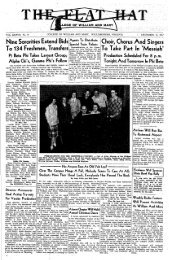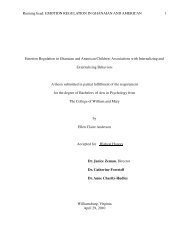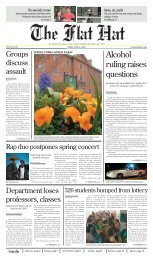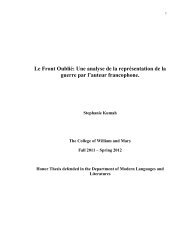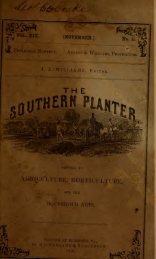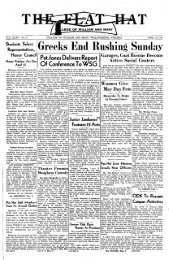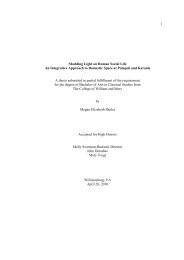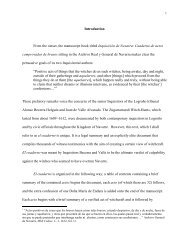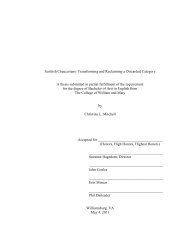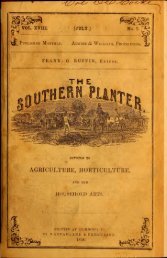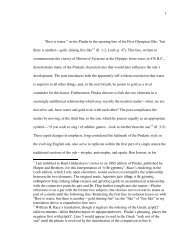Southern planter - The W&M Digital Archive
Southern planter - The W&M Digital Archive
Southern planter - The W&M Digital Archive
Create successful ePaper yourself
Turn your PDF publications into a flip-book with our unique Google optimized e-Paper software.
1908.] THE SOUTHERN PLANTER. 9<br />
ply the needed nitrogen and change the mechanical and<br />
physical condition of his soil to one corresponding more<br />
nearly with the requirements of such a rapidly growing<br />
crop as corn.<br />
Effect of Change of Location.<br />
We have demonstrated that the choicest types of thoroughbred<br />
Western corn, when brought to this section,<br />
are changed materially during a single season of growth,<br />
owing to the readiness with which corn adapts itself to<br />
a new environment. By using the native corn for mother<br />
plants and the eastern seed as a source of pollen, it was<br />
thought that desirable changes could be brought about<br />
much more readily than by bringing in thoroughbred<br />
Western seed and attempting to adapt it to a new<br />
environment. <strong>The</strong> value of this method seems to be<br />
justified by our results, and the practice involved to<br />
effect improvement is so simple that it can be adopted<br />
on any farm and, if systematically pursued by all our<br />
corn growers for a year or two and rigid selection followed<br />
thereafter, the yield can unquestionably be<br />
increased quite markedly for a comparatively small out<br />
lay in the beginning.<br />
<strong>The</strong> variety selected wsa a local strain of Learning corn,<br />
which had been grown on the College farm for many<br />
years without any definite attempt at selection. <strong>The</strong> ear<br />
was very solid, but the strain was lacking in uniformity,<br />
desirable type of ear, and depth of grain. <strong>The</strong> average<br />
measurement of twenty ea'rs indicated that the length of<br />
twenty-five grains was about 11.29 inches, and the per<br />
cent, of protein about 8.38. <strong>The</strong> plan of improvement<br />
was as follows: A thoroughbred strain of the same<br />
variety was obtained from the West. <strong>The</strong> ears of this<br />
corn were larger and more uniform in type and the<br />
grains were of greater depth. <strong>The</strong> work was carried on<br />
with forty ears, (twenty ears of the local and twenty ears<br />
of the improved strain being used. <strong>The</strong>se ears were numbered<br />
from one to forty, and the native corn was given<br />
the odd numbers, and the Western corn the even num-<br />
bers. <strong>The</strong> ears were all planted in separate rows in the<br />
breeding plat in regular order from one to forty, so that<br />
in no case were two ears of the same strain of corn<br />
planted side by side. A piece of uniform land was surveyed<br />
off, making exactly two-thirds of an acre. Each<br />
ear occupied a space of 10x100 links, or 1-100 of an acre.<br />
<strong>The</strong> seed was planted in hills 39.6 inches in each direction<br />
and two stalks were left to the hill.<br />
A review of the data presented indicates that starting<br />
with not more than forty ears of corn it would be possi-<br />
ble, through selection, to obtain an unlimited number of<br />
strains, all presenting some of the characteristics of a<br />
given variety and yet, withal, possessed of striking differences<br />
as to the character and shape of the ear, the size,<br />
shape and quality of the grain, the straightness of the<br />
rows, the covering of the butt and tip, the firmness of<br />
cob and grain, size and character of stalk, earliness and<br />
lateness, per cent, of grain to cob and total crop, number<br />
of grains per ear, and the weight per individual ear.<br />
<strong>The</strong>se are but a few of the physical variations thait appear<br />
in working with a comparatively small number of ears<br />
of corn of a variety that has been in existence and sup-<br />
posedly standardized for years and years.<br />
<strong>The</strong>se facts show that to. effect evolution by 'this method<br />
it is necessary to isolate the particular individual possessed<br />
of those special qualities sought. This is a more<br />
difficult undertaking than is generally thought to be the<br />
case, but when the right ears are located, one is then in<br />
position to go forward through systematic selection and<br />
perpetuate a sort that will give increased yields and<br />
possess many useful characteristics not transmitted with<br />
uniformity by what are regarded as pure strains of the<br />
variety. It must be apparent to all that the strain of<br />
corn has a wonderful effect; on its utility, and that thousands<br />
of strains are on the market of supposedly stand-<br />
ard breeding which fall far below the requirements of<br />
that variety, and it is due to this fact that there is such<br />
a strife over their use in many localities, for it has been<br />
demonstrated on our experimental plats that several<br />
strains of a given variety grown even in a single state<br />
possess widely different characteristics, some desirable<br />
and some equally objectionable. <strong>The</strong> choice of a strain,<br />
therefore, is a matter of serious concern, as it now<br />
appears that the progeny of only three ears out of all<br />
those so carefully selected and tested in our breeding plat<br />
are worthy of permanent preservation and selection, yet<br />
the work involved in two years in handling and recording<br />
the qualities of hundreds of ears has been enormous.<br />
<strong>The</strong> yield varied with the forty ears in 1905 from 2S.14<br />
to 57.26 bushels, a difference of 29.12 bushels. Two sea-<br />
son's work shows that some of the ears have the ability<br />
of transmitting their desirable qualities while others vary<br />
widely. Out of the whole lot there are only three strains<br />
which impressed us as worthy of perpetuation <strong>The</strong>se<br />
were ear No. 11, which made a yield of 46.53 bushels in<br />
1905 and 72.99 bushels in 1906; ear No. 23, which made<br />
a yield of 41.73 bushels in 1905 and 78.46 bushels in 1906;<br />
and ear N'o. 35, which made a yield of 54.94 bushels in<br />
1905 and 81.69 bushels in 1906. Notice that these three<br />
ears made a substantial increase in the yield per acre the<br />
second year from planting, and they have retained all the<br />
desirable characteristics of the original ears planted,<br />
together with the grafted quality of high yields and<br />
uniformity in type and ability to transmit the most valu-<br />
able qualities from one generation to another.<br />
<strong>The</strong> foregoing data is presented for the study of the corn<br />
grower, and if he will follow some of the deductions which<br />
may properly be drawn from the work, he will learn much<br />
that will be helpful to him, and it will do more for the<br />
permanent betterment of the corn crop than anything else,<br />
because it will convince him of the wide variability of<br />
corn under different conditions, of the individual charac-<br />
teristics, good and bad, which are evidenced, and the fact<br />
that the master of the situation—ithat is, the trained<br />
human being—can dominate it and increase or decrease,<br />
add to or take away from the desirable and undesirable<br />
qualities of the corn plant, and so materially affect the<br />
yield of his crop if he undertakes the work intelligently.<br />
ANDREW M. SOULE.<br />
(To be continued.)<br />
CORN FODDER AND LIME.<br />
Editor <strong>Southern</strong> Planter:<br />
I am in hearty sympathy with your campaign for the<br />
careful saving of the whole of the corn crop. I believe<br />
that In every part of our section the entire plant is worth



